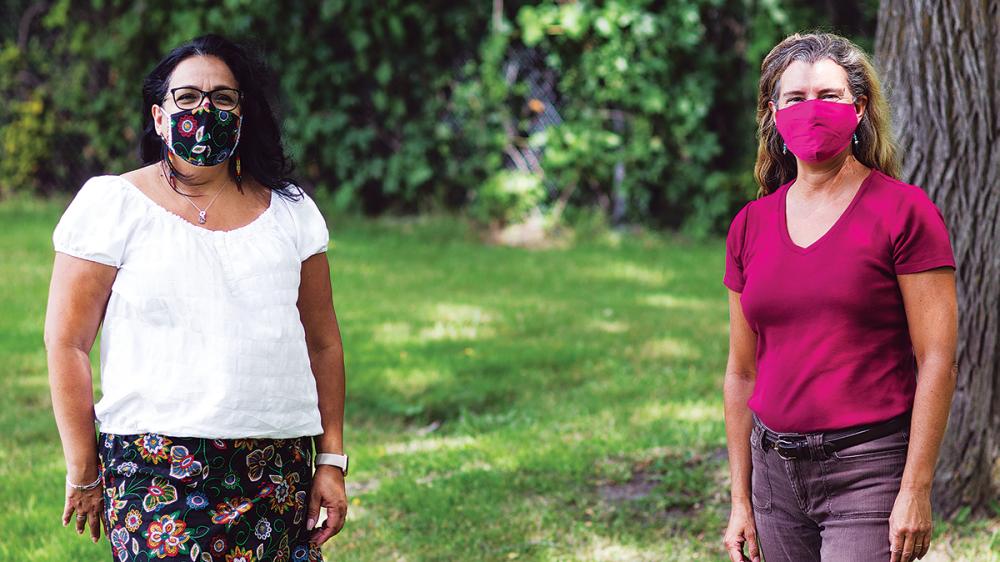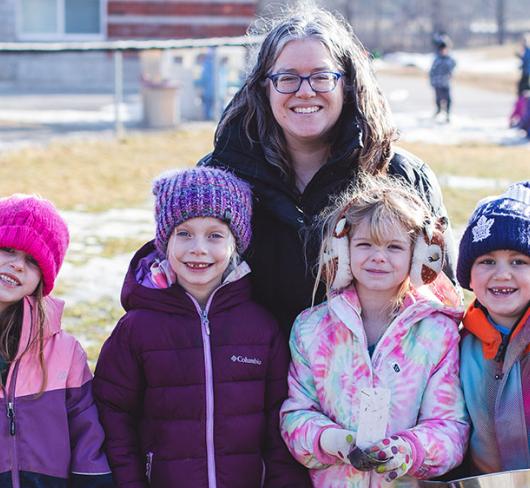
Math on the Land
An Elder once said, “We have two eyes, two ears and one mouth so we can watch and listen twice as much as we speak.” Listening to Indigenous communities along with teaching about Canada’s history of colonization, practices of forced assimilation and continued treaty relationships means staying away from trivializing crafts such as paper plate Dreamcatchers.
As educators charting a way forward and working through the recommendations of the Truth and Reconciliation Commission, we must continue to decentre Western ideologies and ways of thinking about science, mathematics and history. Canada’s long educational history of assimilation and lack of representation has led many Indigenous students down harmful paths within the education system. For years, institutional and systemic colonialism reproduced existing systems of power, domination and oppression. Part of our work as educators is decolonizing the education system and working to include a multitude of perspectives, particularly those that have been traditionally marginalized.
Math on the Land
We began our learning journey focused on Indigenous approaches to math education as a primary staff in the 2018-19 school year at Lakeside Public School in York Region through a professional learning collaborative called “Math on the Land.” First, we connected with a number of people including the board’s First Nation, Métis and Inuit Consultant, Ojibwe Language Regional Teacher and a local community member from the Chippewas of Georgina Island First Nation. As educators, we needed to centre and prioritize relationship building through listening to Knowledge Keepers, communities, families and students. We knew this was necessary for the Indigenous students and families in our community to feel safe within our school learning environment where we hoped all felt respected and welcomed. Key to welcoming all students is the removal of bias, all forms of systemic racism and the meaningful inclusion of relevant and inclusive resources.
Learning a New Calendar
We learned there are many different names for the Grandmother moon cycle specific to each First Nation community. The names are tied to phenological events that happen in nature. Phenology means cyclical and seasonal natural phenomena, especially in relation to predictable changes in daylight and climate and how these affect cyclical occurrences in plant and animal life.
These natural phenomena are very particular to geographic location. The moon names are often related to the natural events that occur in that lunar cycle.
Anishinaabe, Cree and Haudenosaunee consider the turtle shell a calendar that marks the 13 moon cycles represented on the back of the turtle’s shell. We learned the circle of 28 smaller scutes around the edge represent the days for each lunar cycle. Together these form the calendar year (13 x 28 = 364 days). This newfound awareness and knowledge taught us the importance of partnering with Indigenous community to learn the names for each lunar cycle within our particular geographical area, as the names will differ depending on the phenological occurrences across Turtle Island.
Much of Indigenous knowledge is place-based to a specific territory or region. Learning on the land in collaboration with community Elders and Knowledge Keepers means listening and sharing stories and experiences. Collaborating with local Knowledge Keepers contributes to developing community relationships. These partnerships need to be and are often reciprocal in nature so both sides benefit from the relationship. We began this process with sema or tobacco and gifts for our guests.
Shifting Our Learning
We were on a journey to decentre our existing Eurocentric knowledge systems and consider “coming to know” through experiential holistic learning alongside Knowledge Keepers and community. Much of our learning was connected through storytelling and language. We made the space and time to hear personal stories of porcupine quill basket making, beading, connections to land and water, along with teachings of the language for the Anishinaabe number system. In this way, Indigenous knowledge and ways of knowing led to many truths based in life experiences.
Next in our professional learning community, the primary staff examined the resource Natural Curiosities, A Resource for Educators: The Importance of Indigenous Perspectives in Children’s Environmental Inquiry (2nd Edition) as a mentor text to support us in an inquiry-based, knowledge building model within our PLC. We also leaned on Juliet Robertson’s books Messy Maths and Outdoor Learning: Maths in the Early Years on her Creative Star blog for ideas to take math learning outside.
Learning On the Land
Our goal for young students is to provide a hands-on opportunity to learn math outdoors in connection to the land and we were open to knowing it may look very different than our current system of learning. Using hands-on, experiential strategies helps to solidify math concepts and engage learners who might otherwise tune out in class. We also made connections to art activities, such as symmetrical and asymmetrical designs and pattern designs with stones and leaves. We considered other ways of learning such as exploring and naming the plants and wildlife in our own local surroundings. Getting students out on the land as much as possible and learning in connection with nature is engaging and beneficial for students.
We connected the frameworks of teaching math outside with the natural occurrences for each moon cycle. The primary staff surveyed the schoolyard for where we could bring students outside for each of the math strands. We documented ideas on a giant map of our schoolyard. In doing this, we became very optimistic about the huge potential for teaching math outside and inspiring student engagement.
The previous year, we had won Natural Curiosity’s Edward Burtynysky Award for Excellence in Environmental Education for the PLC on “Water Inquiry with an Indigenous Perspective.” With our grand prize money we purchased supplies as well as books from Goodminds, a First Nations family-owned business located on the Six Nations of the Grand River. We also collected some loose parts, such as pine cones and sticks. However, we learned that these items are readily available in nature and in hindsight we recommend leaving them there. They will be there waiting for you when you go outside. Also, due to the new COVID-19 protocols, having each child collect, work with and then leave their individual supplies from nature on the ground where they came from is a form of respecting our Mother, the Earth, along with the safest thing to do.
Once we had developed our ideas for math lessons and identified resources, we began to take our students outside for math more frequently. We used a wider range of the schoolyard. Our learning culminated in a celebration with all classes doing math outside at the same time. Each class worked in a different part of the schoolyard. We engaged students in open-ended math activities with loose parts. All students in grades one to three learned to count to 20 in Anishinaabemowin, while Kindergarten students learned to count to 10, all with the support of our board’s Regional Language Coordinator. We then invited families and system leaders from our board to observe the students learning math outside. It was a very successful day all around with students, families and community.
Here are two examples of the collaboratively built outdoor student learning activities for the specific time of the year in our school yard:
Binaakew Giizis Moon
(Falling Leaves Moon - October)
Activities for strands:
Social and Emotional Learning (SEL) and Number Sense
Build resilience and sense of identity: Draw and design numbers with sticks and loose parts.
Spatial Sense: Sort, identify, compose and de-compose shapes with natural objects.
Algebra: Create and describe patterns with leaves.
Data Management: Collect and sort colourful leaves by attributes. Organize collections into pictographs and bar graphs.
Makwa Giizis
(Bear Moon - February)
Activities for strands:
Data Management: Use mathematical language, including the terms “impossible,” “unlikely,” “equally likely,” “likely,” and “certain,” to describe the likelihood of weather events.
Number Sense: Use snow designs to create fair-share representations and problems.
Social and Emotional Learning (SEL) and Spatial Sense: Go for a walk outside with the class to respond to stress and help them build personal resilience; look for patterns in and around the schoolyard, such as cloud and weather patterns and patterns in the built environment. Students record reflections in their math journal.
We encourage others to take their math curriculum outside. Even though we can’t bring community members into our classrooms this year due to COVID-19, there are other ways for classes to connect with Elders and Knowledge Keepers including Zoom and Google classroom. Find ways to connect with the natural events occurring in your environment. Trust that the “loose parts” will be there and encourage students to be curious and to learn that there are different ways of knowing. Stay open to new learning opportunities. Make sure you and your students have a way to record your work, such as a digital device and math journals. Encourage students to identify and communicate the knowledge they build about math concepts using the natural environment, such as estimating what a metre is using a stick, leaves or pine cones. Create a culture of math talk where students can build on each other’s knowledge, listen and ask questions that lead to further inquiry. The excitement of learning outdoors will create a dynamic learning environment that will lead to greater student engagement and optimism while solidifying understandings of math concepts. Learning outside has infinite potential to engage learners in the curriculum, and it has the capacity to support us in promoting physical distancing.
Collaboration with the community ensures accuracy and avoids tokenism. Decolonizing education is a reciprocal process and a continual learning journey along a path of greater knowledge and understanding. As teachers, if we promote land-based, outdoor experiences that are student-centred and place-based, we support our students in thinking deeply, listening, reflecting and constructing their own knowledge about nature and themselves. We help them become intrapersonally intelligent, that is, we teach them how to calm and centre themselves, and learn to trust that nature – Shkagamik-kwe or Mother Earth – will be there for them through tough times. These lessons and connections to Shkagamik-kwe are perhaps the biggest gifts we can give our students today.
Jennifer Baron and Towana Brooks are members of the York Region Teacher Local.

